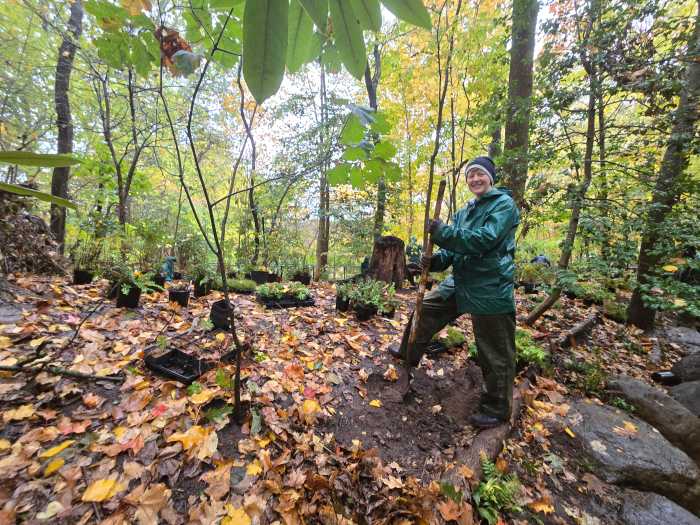Monochromatic master requisitions Chelsea gallery to stake a claim on perspective
On view in three galleries at Cheim & Read in Chelsea is the first solo exhibition of the new work by Paul Morrison, a British artist who has international recognition for his bold graphic black and white paintings, prints, and films.
In the curtained chapel-like space of the front gallery, a new DVD projection entitled “Satellite 2004” is featured. The amplified sound of a gale force wind accompanies the large, carefully framed projection of images during what appears to be a storm at some mountainous region. The black and white images fade from mountains and firs to the tree line. Branches are shown as abstract shapes. Any of the images could stand as individual compositions. Images of the sun and moon, black and white, fade into stars in a night sky. There is a pan of reflections of trees on water, mirror images, red woods, and clouds moving in front of the moon.
The quality of the DVD is extremely grainy and low resolution, like that of a surveillance camera. There is no human or animal life in the DVD, only the constant strong wind and the stormy elements. The changing images and constant sound are quite hypnotic and foreshadow themes in the other two galleries.
The main gallery contains “Tetraspore 2004,” a painting of 360 degrees stretched across the four walls. The visual vocabulary generated by the DVD is now directly painted on the gallery walls. Large black on white hard-edged shapes of fir trees and large vertical arcs frame close-ups of the boughs. Noted for his attentive framing, Morrison uses the ceiling and the floor to form stark borders while also framing the piece internally.
A suggested horizon line evokes landscape and a sort of graphic pastoral setting. Once again, pine branches with cones, dandelions, thistles, leaves, and the moon are alternately depicted from close up and from a distance. The bold black-and-white graphics create a large-scale pop wallpaper.
In the small back gallery, a large, round painting, “Filament 2004,” acrylic paint on aluminum, features a close-up of a thistle flanked by fir trees. A very slick, hard-edged effect seems to have been attained by taping off areas to delineate the sharp, pointy quality of the thistle. This mostly white painting is shown on a black painted wall—once again a distinct framing device.
A small acrylic painting is hung on each of the other three walls. Botanical elements are again rendered, once more employing an internal framing device, but here the style resembles woodcut. The only image of a man-made object (other than the geometry) is “Tarn 2004,” which pictures a landscape that is the site of a fantasy cottage. This piece seems to be striving to evoke an era apart from contemporary art.
Spending time with Morrison’s art, I was able to savor the gray of the wet sidewalk outside the gallery, to appreciate the silhouette of a just-budding branch tip against a street light. A white starburst magnolia against the dark wall of a wet brownstone really caught my gaze.
We also publish:
Advertising




































